- Home
- About S&T
- Taxa/Organisms
- Ecosystems
- Issues
- Methods & Tools
- Reports & Publications
- Location
- Search
2008 | Publisher: Other (RSC Publishing, Journal of Environmental Monitoring) | Format: URL
www.rsc.org — Environmental contaminant and biomarker monitoring data from major U.S. river basins were summarized for black bass (Micropterus spp.) and common carp (Cyprinus carpio) sampled over a nine year period. Cumulative frequency distributions revealed taxon differences for many organochlorine residue concentrations, elemental contaminant concentrations, More...

2008 | Publisher: USGS | Format: URL
pubs.usgs.gov — This study determined that concentrations of persistent hydrophobic contaminants, such as polycyclic aromatic hydrocarbons (< picograms per liter), legacy pesticides (<10 picograms per liter), and polychlorinated biphenyls (<280 picograms per liter) were low and indicative of a largely agricultural area. Atrazine and simazine were the most More...

May 4 2007 | Publisher: Other (Springer New York) | Format: URL
www.springerlink.com — This project is an evaluation of three potentially nonlethal alternatives to fillet sampling for the determination of mercury (Hg) concentrations in smallmouth bass (Micropterus dolomieu) to monitor mercury concentrations in smallmouth bass (micropterus dolomieu) from six sites in southern Missouri were captured by electrofishing. Blood samples More...

2002 | Publisher: USGS | Science Center: Western Fisheries Research Center (WFRC, Seattle) | Format: URL
wfrc.usgs.gov — The value of this long-term monitoring program will provide data crucial for understanding demographic and reproductive characteristics of these endangered sucker populations. This research will have wide applicability to federal, state, and tribal agencies in the basin for management and recovery efforts.
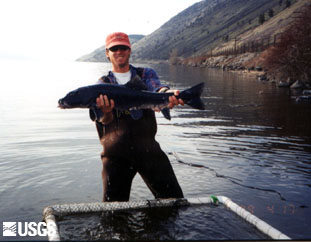
2002 | Publisher: USGS | Science Center: Great Lakes Science Center (GLSC, Ann Arbor) | Format: .PDF
www.glsc.usgs.gov — In 2002, scientists from the Great Lakes Science Center assessed the health of the populations of preyfish for the biennial State of the Lakes Ecosystem Conference (SOLEC) to provide information to policy makers on the status of the lakes and future needs. Preyfish population is one of the 80 indicators used by SOLEC to determine the health of the More...

September 10 2000 | Publisher: Other (Grand Canyon Monitoring and Research Center) | Format: .PDF
www.gcmrc.gov — Lees Ferry was stocked with Rainbow Trout in the early 1960`s. Since then, it has been a nationally acclaimed and world renowned blue ribbon fishery. With its value as a recreational play land for fishermen and safe haven for wildlife, the function and impact of the Glen Canyon Dam has become increasingly important for study and monitoring.

Publisher: USGS | Science Center: Western Fisheries Research Center (WFRC, Seattle) | Format: URL
wfrc.usgs.gov — This project addresses the occurrence of metal and organochlorine contaminant residues in commercial feeds purchased by the U.S. Fish and Wildlife Service (FWS) hatcheries. Research into fish feed quality could benefit all hatchery and aquaculture operations and assist in the interpretation of the effects of pollution on wild fish. Results from More...
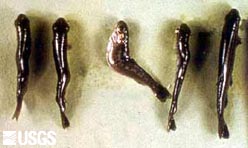
Publisher: USGS | Science Center: Upper Midwest Environmental Sciences Center (UMESC, LaCrosse) | Format: URL
www.umesc.usgs.gov — Paddlefish (Polyodon spathula) have been lost from four states and Canada, and 11 of 22 states within the remaining species range now list the paddlefish as endangered, threatened, or a species of special concern. Restoration of paddlefish populations is a shared goal of many state and federal agencies. UMESC scientists, in collaboration with the More...
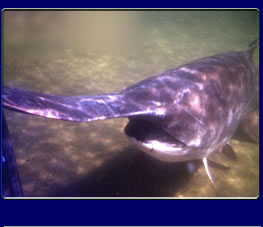
Publisher: USGS | Science Center: Western Fisheries Research Center (WFRC, Seattle) | Format: URL
wfrc.usgs.gov — Salmonid species in the Pacific Northwest continue to decline despite management efforts to mitigate the effects of development of the Columbia River basin and power system. Altered fish species diversity and changes in the aquatic habitat have created the need for research to determine the status, life history, and habitat requirements of at risk More...
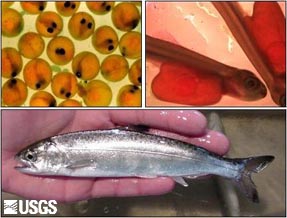
Publisher: USGS | Science Center: Western Fisheries Research Center (WFRC, Seattle) | Format: URL
wfrc.usgs.gov — This is a research summary who's project objectives are to: 1) Coordinate watershed stakeholders in order to guide the implementation of watershed restoration actions that are consistent with stakeholder objectives, 2) Monitor physical habitat conditions and natural production of juvenile, smolt, and adult steelhead in the Wind River sub-basin, More...

Publisher: USGS | Science Center: Western Fisheries Research Center (WFRC, Seattle) | Format: URL
wfrc.usgs.gov — This research summary reports on the decline of Pacific lampreys (Lampetra tridentata) in the Columbia River Basin. Their numbers have declined to only a remnant of their pre-1940's populations. One factor that could be detrimental to lamprey production is the amount of energy they expend negotiating upstream fish passage facilities at dams. An More...
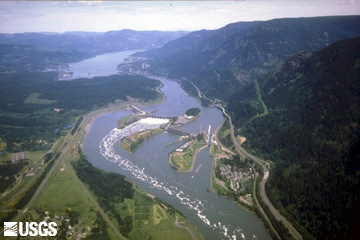
Publisher: USGS | Science Center: Western Fisheries Research Center (WFRC, Seattle) | Format: URL
wfrc.usgs.gov — The goal of this study is to determine egress routes and egress timing of juvenile salmon with respect to passive particle movement in the tailrace of John Day Dam using ultra-sonic fish tracking technology. The objectives are to evaluate egress routes and egress timing of juvenile spring chinook salmon with respect to paired releases of neutrally More...
